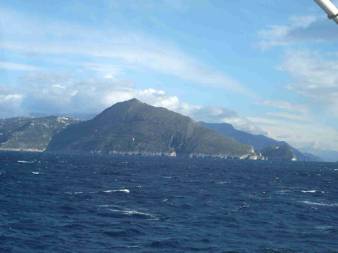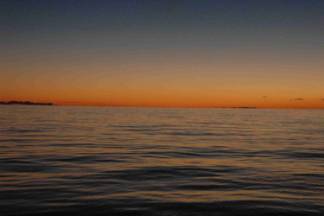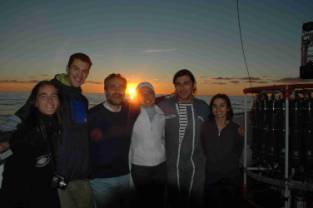During the second leg of the winter cruise, the hydrobiological survey focused on seasonal patterns in physical variables and biological components in the Tyrrhenian Sea, logically following the CIESM SUB1 campaign undertaken in the same area six months earlier.
A new sampling strategy was applied in order to better define a mesoscale gyre structure in the southern Tyrrhenian Sea. While still poorly explored, this deep-sea plays a key role in the complex dynamics of water exchanges and biological fluxes between the eastern and western sub-basins, thus impacting on ecosystem functioning and biodiversity.
Nineteen scientists and two technicians, all with specific expertise in the field of geophysics, physical oceanography, biochemistry or microbiology and coming from different Italian, French and Tunisian research institutes, participated to this part of the multidisciplinary campaign and shared the life onboard the R/V Urania.
Responsible for the coordination of the research activities onboard was the chief scientist Franco Decembrini. Here, he gives some impressions and a personal evaluation of the outcome of the cruise.
[Dr Carolyn Scheurle, CIESM HQ]
------------------------------------------------------------------------------------------------------------------
Notes of the chief scientist, Franco Decembrini
In the beginning, the cruise was affected by unstable weather conditions and, due to the unfavourable weather forecast, we (the R/V Urania team) decided to leave the port of Messina one day later than scheduled, i.e. on 14 December. After we left Messina, we were forced to stop at Lipari, one of the Aeolian Islands, for 18 hours to shelter from the strong wind and high waves.
The rough sea during the transit to the study area forced the team to stopover at Lipari, Aeolian Islands.
(Photo: M N. Daly Yahia) |
 |
During the first day of the unexpected stop, we organized a meeting on board. There, the scientists agreed on a new sampling strategy and a basic scientific programme that could be guaranteed, even if the bad weather conditions persisted during the second leg of the CIESM cruise. After these decisions were made, the atmosphere onboard was much better already.
In the early morning hours of 15 December, the sea conditions were still not very good. Nevertheless the R/V Urania left from Lipari and headed towards station #07 located in the main SE-NW transect (see map). We arrived around noon and started the scientific programme with the measurements of underwater light and experiments of phytoplankton primary production.
The sampling on this first station was very hard, but the team worked with enthusiasm: we were starting!
After 33 hours of continuous work and eight stations sampled (very deep: > 3500 meters depth), we were again forced to stop because of the rough sea. The waves were up to 4 meters high and, therefore, it became impossible to use the rosette [a device commonly used in marine sciences to retrieve water samples] and zooplankton net. Because sampling was not possible, and because it was better to wait in calm waters until the weather conditions allowed to restart the work again, it was decided to move during the night towards NE in the proximity of the coast and in the direction of Naples.
It took us seven hours of difficult navigation to arrive at the Ischia-Procida Channel. Only 34 hours later, we departed again, on the 18 December. Hoping for good weather we navigated during the night and the
R/V Urania arrived at the station #17 in the first hours of the next day – and the sea conditions were better.
 |
On the way to the Ischia-Procida Channel the sea is still showing white crests.
(Photo: Franco Decembrini)
|
During the following days the weather situation and sea conditions were very good – almost like in summer - and the work was characterized by strong scientific enthusiasm. When some technical problems were occurring, they were resolved immediately.
Calm, almost summery Mediterranean Sea conditions allowed to work onboard very efficiently during the last few days of the campaign.
(Photo: Franco Decembrini)
|
 |
In this way we sampled ten stations along the main transect (SE-NW) and six within the second transect
(NE-SW;
see map). The good conditions of the sea also favoured the scientific exchange and interactions between researchers greatly benefitted.
 |
After the work was done: the scientists are happy about the excellent teamwork and the valuable data gathered.
(Photo: Fabrizio, technician on the R/V Urania; from left to right: Elisa Malinverno; Fabrice Jaine, Franco Decembrini, Daniela Zeppilli, Christian Tamburini, Violetta Lacono) |
From my personal point of view, as scientific coordinator of this cruise, the major achievement was to favour a good working atmosphere and environment for the scientific team. Having the possibility to work together on the same objectives by using different methodologies led to a high scientific output and fruitful discussions – and, furthermore, we found new perspectives.



